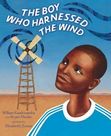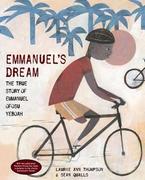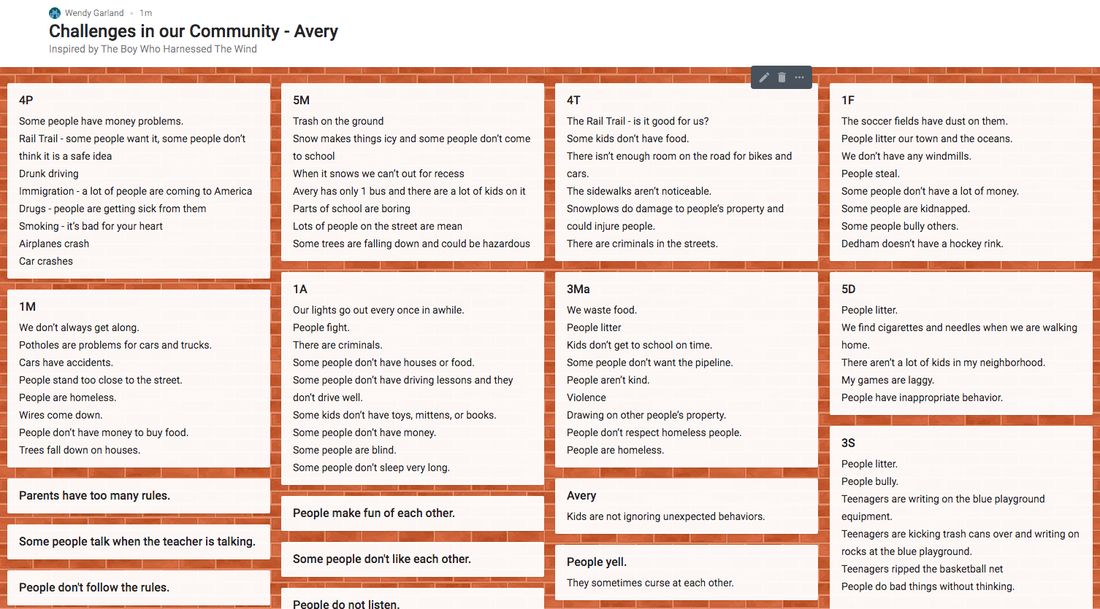
Our community read The Boy Who Harnessed the Wind by William Kamkwamba and Bryan Mealer as a One Book, One Community read.
The different formats enabled my elementary school students to participate. I was excited to have my students think about their community and work together within it to frame our thinking. I outline our project here and on my blog. Together with our cable station we created this video:
We read the book together, pausing periodically to listen for the challenges in William's community. Challenges we identified included:
- No lights
- No rain
- No water
- No food
- No money
- No school
With a working knowledge of what a "community" was and some identifiable challenges in William's community, we were then ready to identify challenges in our own community.
We began with a brainstorm of challenges in our community. For some classes this was too big of a question and they did better with "challenges in our school." I collected ideas on a padlet.
Challenges in our school
- Our playground is vandalized by older students
- Students don't follow the rules
- Students don't treat each other respectfully
- Bullying
- Litter (this came up over and over)
- Some people don't have jobs or money
- Car accidents/bad drivers/poor road conditions
- Rail Trail - is this good for our town or not?
- Money
- Car accidents
- Bullies
- Homelessness and hunger (some classes insisted that these situations did NOT exist in their town) although I assured them that they did and we talked about how these people are hopefully receiving aid from family, friends, and resources in town.
- Immigration
Now it was time for students to choose a challenge they wanted to work on, spend some time thinking about possible solutions and plan how they would do something about it. I had students self select teams (they had the option to work independently or in teams of 2 and 3). They began developing their ideas.
First we brainstormed what kind of projects these might be, thinking about what skills we had that we could employ. Grades 2-5 used this list:
- PicCollage
- Chatterpix
- Build - Legos
- Draw a picture or poster
- Google Slides
- Write a letter
- Write a voicemail message
Students showed their thinking in a variety of formats:
1st graders were given a drawing assignment to show the "before" and "after" of their proposed solution. They drew their thinking.
- We worked hard
- We should do this again
- My team loved it so much
- It was fun and I'm looking forward to doing it again
- You get a lot more work done with a friend
- I am a good teammate
- We worked together and didn't get off track
- I loved this project
- I learned something new
- He was the best windmill maker
- This project is fun and should be done all around the US
- There are a lot of problems here
- The challenge was kind of fun
My takeaways
The assessment confirmed what I felt and saw - students were engaged and invested in their project and their thinking. I enjoyed this project that allowed me to ask the same "big questions" to everyone from grades 1-5. Genuine problems in my students' minds were valued and creative solutions were demonstrated in the project they chose. Students had voice and choice in this project and I would do it again in a heartbeat.

On our final day, I read Emmanuel's Dream: The True Story of Emmanuel Ofosu Yeboah by Laurie Ann Thompson & Sean Qualls to many classes and we made connections between the two stories.
- They are both about a young boy
- They are both true
- They both take place in Africa
- Both boys were trying to make things better
- Both boys had challenges
- Both boys made a difference
| After book selection, students could choose an activity - they could look at student work or take a selfie using the app Comic Touch and share what is great about our school and community. A few of those selfies are highlighted here. | |


